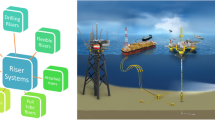Abstract
This work presents a simple and efficient framework for the fatigue reliability assessment of a vertical top-tensioned rigid riser. The fatigue damage response is considered as a narrow-band Gaussian stationary random process with a zero mean for the short-term behavior of a riser. Non-linearity in a response associated with Morison-type wave loading is accounted for by using a factor, which is the ratio of expected damage according to a non-linear probability distribution to the expected damage according to a linear method of analysis. Long-term non-stationary response is obtained by summing up a large number of short-term stationary responses. Uncertainties associated with both the strength and stress parts of the limit state function are quantified by a lognormal distribution. A closed form reliability analysis is carried out, which is based on the limit state function formulated in terms of Miner’s cumulative damage rule. The results thus obtained are compared with the well-documented lognormal format of reliability analysis based on time to fatigue failure. The validity of using the lognormal hazard rate function in predicting the fatigue life is discussed. A Monte Carlo simulation technique is also used as a reliability assessment method. A simple algorithm is used to reduce the uncertainty associated with direct sampling at small probability of failure values and a small number of simulations. Simulation results are compared with closed form solutions. A worked example is included to show the practical riser design problem based on reliability analysis.



Similar content being viewed by others
References
Abramowitz M, Stegun IA (1970) Handbook of mathematical functions with formulas, graphs, and mathematical tables. National Bureau of Standards, Washington DC
ASCE (Committee on fatigue and fracture reliability) (1982) Fatigue reliability (a series of papers). J Struct Div ASCE 108:3–88
Ayyub BM (2003) Risk analysis in engineering and economics. Chapman and Hall/CRC, Florida
Bogdanoff JL (1978) A new cumulative damage model. J Appl Mech 45:246–250
Broding WC, Diederich FW, Parker PS (1964) Structural optimization and design based on a reliability design criterion. J Spacecr 1:56–61
Brouwers JJH (1982) Analytical methods for predicting the response of marine risers. R Neth Acad Arts Sci Ser B 85:381–400
Brouwers JJH, Verbeek PHJ (1983) Expected fatigue damage and expected extreme response for Morison-type wave loading. Appl Ocean Res 5:129–133
Bury K (1999) Statistical distributions in engineering. Cambridge University Press, Cambridge, UK
Chakrabarti KS (1990) Nonlinear methods in offshore engineering. Elsevier, Amsterdam
Harper MP (1979) Production riser analysis. In: 2nd international conference on the behaviour of offshore structures, London, UK, Paper 60
Kirk CL, Etok EU, Cooper MT (1979) Dynamic and static analysis of a marine riser. Appl Ocean Res 1:125–135
Leira B (1998) Reliability aspects of marine riser and subsea pipeline design. In: Soares CG (ed) Risk and reliability in marine technology, Rotterdam, The Netherlands, pp 273–313
Lin YK (1967) Probabilistic theory of structural dynamics. McGraw-Hill, New York
Lutes DL, Corazao M, Hu SJ, Zimmerman J (1984) Stochastic fatigue damage accumulation. J Struct Eng ASCE 110:2585–2601
Melchers RE (1987) Structural reliability analysis and prediction. Ellis Horwood Limited, West Sussex
Miner MA (1945) Cumulative damage in fatigue. J Appl Mech 12:A159
Shooman ML (1968) Probabilistic reliability: an engineering approach. McGraw-Hill, New York
Souza GFM, Goncalves E (1997) Fatigue performance of deep water rigid marine riser. In: 7th international offshore and polar engineering conference, Honolulu, USA, 2:144–151
Sweet al (1990) On the hazard rate of the lognormal distribution. IEE Trans Reliability 39:325–328
Tucker TC, Murtha JP (1973) Non-deterministic analysis of a marine riser. In: 5th annual offshore technology conference, Houston, USA, Paper 1770
Verbeek PHJ, Brouwers JJH (1986) Approximate formulae for response of slender risers in deep water. Int J Shipbuilding Prog 1:22–37
Wirsching PH (1984) Fatigue reliability for offshore structures. J Struct Eng ASCE 110:2340–2356
Wirsching PH, Chen YN (1988) Considerations of probability-based design for marine structures. Marine Struct 1:23–45
Author information
Authors and Affiliations
Corresponding author
Rights and permissions
About this article
Cite this article
Nazir, M., Khan, F. & Amyotte, P. Fatigue reliability analysis of deep water rigid marine risers associated with Morison-type wave loading. Stoch Environ Res Risk Assess 22, 379–390 (2008). https://doi.org/10.1007/s00477-007-0125-2
Published:
Issue Date:
DOI: https://doi.org/10.1007/s00477-007-0125-2




